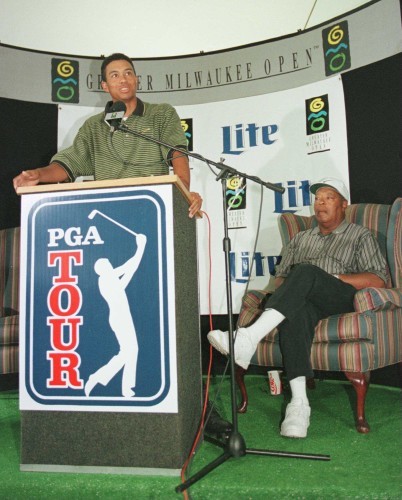THERE WERE TWO questions that Armen Keteyian and Jeff Benedict wanted answered as they began writing their latest book: 1. Who is Tiger Woods? 2. What is the price of genius?
Anyone who has read the 404 pages of the William Hill-nominated ‘Tiger Woods’ will know that they have come closer perhaps than anyone to unlocking the mysteries that characterise this enigmatic and iconic figure.
The meticulously researched book is full of fascinating insights on what makes the US golf star tick and why he is such a brilliant, complex and ultimately flawed individual.
Below, The42 speaks to Keteyian about the exhaustive process of putting together the book, as well as delving into a number of the themes it explores…
What made you decide to write the book?
We had just finished a book called ‘The System,’ which is a deep dive into big-time college football. We were looking for another big project. Our agent, Richard Pine, suggested it. We both kind of looked at each other and said: ‘Haven’t there been enough Tiger Woods books written at this point?’
We said: ‘Let’s take a look.’ And it became clear rather early on that yes, there had been a lot of books written, but there had never been an immersive 360-degree book on his entire life. Most of the other books had been written about particular times in his life. Just after he turned pro, certainly golf writers had written about him and his father ended up writing three books about his experiences with Tiger.
And then again, after the scandal in ’09, in 2010, there were a number of books that came out. But there had never been that deep dive, the intelligent biography that we were searching for. So we decided to plunge in and we wanted three years to do it, because we knew that to do it the right way, it was going to take a lot of time and research, to do the kind of reporting we wanted to do
But also, to find people who hadn’t been found before and gain their trust, and hopefully get them to speak either on the record or on background. And that’s how it turned out.
Between the two of us, I believe Jeff and I have written 25 non-fiction books. Not all of them in the world of sports, but all of them were leading to issues or biographies of people. This was by far the hardest task we’ve ever undertaken — nothing was even close to it.
It was the high-stakes nature of the writing, all the work that went into finding people and then gaining their trust. In the end, those couple of years really paid off. It took us in some cases as much as a year for people to decide that they were going to speak to us.
It sounds like quite a painstaking experience?
I don’t know how many times Jeff and I looked at each other and said: ‘Whose idea was this?’ It was painstaking. It was arduous. It was overwhelming at times in terms of the pure scope of his life. Tiger is soon to be 43 and it’s like he’s lived two lives just to get to the age of 43.
In the end, it was very rewarding. We’re both very proud of what we produced. I think it took every bit of the journalism skills that we have in terms of investigative skills, in terms of our writing, in terms of our ability to find people, and we had help with some very talented reporters. But it’s a lonely job. I pretty much spent the entire 2017 year doing nothing but Tiger, and Jeff was pretty much in the same boat. It was two full-time jobs for the last 18 months and a full-time part-time job in the time preceding that.
Was it easy to leave behind your normal day-to-day commitments?
I got a break, so to speak. This is Jeff’s full-time job. I was working at CBS News at the time. When ’60 Minutes Sports’ — the offset of ’60 Minutes’ that runs on the cable network here, Showtime — it was unexpectedly cancelled and our last show was in March 2017.
My particular circumstances were such that I had a guaranteed contract until September 2018. Because of the way my contract was handled and how it was written off, I wasn’t able to be on the air. I was being paid, but I wasn’t allowed to be on network television.
So it provided an unexpected opportunity for me to devote myself full-time to the book. Honestly, the book would not be what it is without that unexpected time I could put into it.
So it was kind of a blessing in disguise in many ways for me, and it turned out to be probably the best thing that could have happened. Things work in strange ways, and that was an unexpected twist to my life, and it turned out to be a gift I thought we were never going to get.
You approached Tiger and asked if he would be willing to speak, but I guess it was more in hope than expectation?
It didn’t take long to understand that Tiger really doesn’t want to speak to the media unless it’s under very specific circumstances — that’s generally a golf tournament, or at his fundraising foundation events, when there’s something in it for him.
We understood that going in and reached out to his representatives, Mark Steinberg and Glenn Greenspan, in January 2016 via email. All we were really looking for at the time was an opportunity to sit down with Glenn or Mark to discuss the parameters of our reporting. And to answer any general questions they might have about what we were looking to do in the hopes of getting an interview.
In response, we got a nasty, frankly insulting email back, giving us journalism lessons, saying before they would even consider giving an interview, we had to tell them everyone we had talked to both on and off the record, everything they had said to us, and we had to provide Tiger with a list of questions prior to the interview.
’60 Minutes’ doesn’t accept those kind of conditions with heads of state. So we said we’re going to agree to disagree.
Then, we went back to him a number of other times, including within the last month right before publication. We again said to them: ‘We’re getting ready to go to press, these are the specific areas we would like to speak to you about.’ By that time, we had very specific questions related to those areas, and again, we gave them a deadline of 8 February and did not hear a word from them until 9 February, when they sent another email giving us more journalism lessons.
So it was not unexpected, but it didn’t have to go the way that it went. With Tiger and Tiger’s people, basically if you’re not 100% pro-Tiger, you’re in the shitter with them. So that’s just the way it is. We’re all adults and professionals. But I honestly didn’t think that we had to descend to the kind of language we were reading from them.
Tell us about how the collaboration process works between yourself and Jeff. Does one of you do more writing or reporting than the other?
In ‘The System,’ we wrote individual chapters and we rarely collaborated on much of what was going on between the two of us, because we had particular advantages with certain schools, whether it was Washington State with Mike Leach, or Alabama with Nick Saban.
This was different. We knew we had to at least have an attempt at one voice. In ‘The System,’ there were 28 chapters — Jeff wrote 16 and I wrote 12. In this case, we collaborated a lot more in terms of who was going to talk to who, how we were going to approach certain people, what areas that we were going to focus on.
In the end, for the most part, I wrote very long narrative sections of the book. Then, I would send them to Jeff, he would use his reporting, he would add to the section, polish it and send it back to me. I would make more changes, polishing, and send it back to him.
So probably it’s more Jeff’s voice in the book, but there are particular sections and particular chapters — the Vegas chapter, which is called ‘In the Bubble,’ the question of performance-enhancing drugs chapter, ‘Miracle Workers,’ I wrote those because I was immersed in those worlds.
If you’re trying to put a puzzle together, we were all crafting the pieces together separately and then we stuck them together.
In the end, it has more of Jeff’s tone to it than mine. We both agree that for this to work, given the scope of what we were dealing with, one person at least had to be putting the bassline down and then we could play with that. In the end, it turned out to be Jeff, because I spent a lot of time reporting things too.
One of the early parts of the book focuses on the ridiculously young age at which Tiger is expected to go in front of cameras and deal with fame. Did he struggle in particular with those pressures?
Do you really know what you’re doing when your two-and-a-half years old? You look at that video of him on the stage [on 'The Mike Douglas Show']. He’s just got his finger in his ear and he’s playing with his ear. He’s nervous, he’s anxious.
When he’s five, he’s on ‘That’s Incredible’ and he’s sitting on the lap of the host, it’s almost like he’s a wind-up toy that you wind up and you put him on stage.
So much of this book — to understand Tiger Woods, you have to understand Earl Woods and Tida Woods. The power of the story, the power of the book comes from the arc of Earl’s life, what he experienced racially and socially, what Tida experienced growing up in Thailand. There’s no question that they had a profound influence on Tiger, good and bad. To understand who Tiger is today, you have to look through the prism of Earl and Tida. That, for us, as storytellers, is what made the book so fascinating.
We knew there was this incredible arc, because if you know anything about Tiger Woods, you know he was a child star who won three US juniors and three US amateurs.
Anyone that was alive and over the age of five in 1997 knew what he did at the Masters. What really benefited us was we put this massive timeline together that in the end ran at 120 pages.
I think what was a huge difference maker was in the success of the book and the narrative flow of the book — we found people, instances and incidents that slotted in between the major events in Tiger’s life that helped you understand who he was prior to, during and after those events.
So when he crashes into that fire hydrant in November 2009, it’s taking you three quarters of the way through the timeline, you know what’s going on in his life. He’s having multiple affairs, he’s further estranged from his family, he’s under tremendous pressure physically, he’s a tortured soul at that moment in time. So you don’t look at the accident as an accident. You almost look at it is an inevitability. He was going to crash someway somehow — it just happened to be with a fire hydrant.
Did Earl’s death in 2006 contribute to and accelerate his destructive behaviour?
The word ‘accelerate’ is a very good word. He says certain things about his dad, he misses him, but Earl was an anchor. You almost see it as somebody who is jumping out of a plane, but they’ve got a safety harness where they’re tethered to something. When Earl died, that safety line snapped, and it just added to the acceleration of the fall. It was that epic fall — you could definitely tie it back to 2006.
Their relationship diminished and they were spending less and less time around each other by 2006. But when you lose somebody like Earl — the good, the bad and the ugly — as a son, as close as they were, I don’t think you can minimise it in any shape or form, the impact it had on Tiger.
You can easily forget how big a deal it was in the mid ’90s, when Tiger emerged, in terms of his influence on black people and the way black athletes are perceived. Would it be fair to say he was a little reluctant or uncomfortable embracing this role?
It was always Earl that was pushing the racial narrative. Because to Earl, it was really important, given what had happened in his life. Tiger was Earl’s revenge in a lot of ways racially. In terms of all the snubs and the discrimination and the racism he faced in the military and in growing up in Kansas. Even at the golf club, where he was called ‘Sergeant Brown’.
I think Tiger saw himself as more Thai than he did African-American. That narrative was pushed by corporations — certainly Nike. ‘Hello world’ and ‘I’m Tiger Woods’ — those two commercials.
So he was very reluctant to take centre stage on race and if you look at his foundation and the so-called Tiger effect on bringing African-American golfers to the game, there’s one African-American golfer now, Harold Varner III, on the PGA Tour, and there are very few elite African-American junior golfers right now.
But if you look at the effect Tiger had through his foundation on people of colour, Vietnamese, African-American, Korean, giving up educational opportunities to people that would otherwise not have them, certainly to the degree that Tiger’s foundation has provided them, that’s an enormous impact that far outweighs anything he’s done in sports.
At the Tour Championship, it was reminiscent of ’97 at the Masters when he goes to the Western Open at a course called Cog Hill, which is just outside Chicago.
There’s a moment where, on the 18th fairway, it’s a foregone conclusion that he’s going to win the golf tournament. But he hits a shot on the fairway that ends up in the green and the fans in the gallery break through the rope lines and it looks like the British Open, where they surrounded him as they came up the fairway. He was like Moses.
And it was the same scene in 2018, 21 years later, at that Tour Championship, and you’re just thinking: ‘How many athletes in the world ever can do something like that, which can engender that kind of response two decades apart?’ It’s amazing that he retains this — it’s almost an unexplainable impact on people in the world of golf.
There were fans there that I’m sure had never picked up a golf club in their life, but they wanted to be part of that scene that day at East Lake.
In terms of the chapter on the question of performance-enhancing drugs, how strong do you think the evidence is for and against?
If we had it, we would have printed it. There’s nothing we ever found. I know this world pretty well and I looked rather hard for the better part of a year. We said what we felt comfortable with defending.
And that statement that Mark Lindsay gave, the declaration that ends that chapter is an extraordinary document, because it’s the first time that anybody who’s been close to Tiger has ever gone on the record with their opinion of whether he ever has used PEDs. For us to get that statement, Tiger had to sign off on and waive doctor-patient privilege in a legal document. That was the only time in all of our efforts that there was any kind of co-operation from Tiger or Tiger’s camp.
And I’ve known Mark Lindsay for more than 20 years. He’s as good as it gets when it comes to chiropractic massage and active-relief techniques. In everything he does, he’s a world-class doctor.
And for him to say what he said, to me, until somebody else comes along with a smoking gun, and by that I mean an eyewitness account who goes on the record, or a document that would stand up in a court of law, I think the answer is that nobody has proof that Tiger did anything. You can speculate until the cows come home, but that is the third rail as far as the Woods camp is concerned. If you’re going to make that allegation, you damn well better have proof. And we went as far as we could and felt comfortable going.
After the sex addiction treatment, are you convinced Tiger is now genuinely a changed man?
In talking to the people I talked to, one of whom had been through the exact same treatment and protocols that Tiger went through at the exact same facility just weeks before, and from talking to sex-addiction experts, I don’t think you can go through that programme for 45 days and not change or see yourself in a different light. It’s virtually impossible given the kind of places you find yourself in during treatment.
But if you’re asking is he a changed man, I would say yes. But I would point to the Memorial Day traffic accident in 2017 and that weekend where he found himself on the side of the road in Florida thinking he was in California, with a rock star cocktail of very powerful drugs in his system — I think that was the moment Tiger hit rock bottom.
Looking at himself as a father to two children, he absolutely adores and lives his life for them — I think that’s what changed. He did not want to be that kind of father to those kids. I think he is a different person.
I saw him in January 2018 at Torrey Pines at the Farmers Insurance Open and he was more appreciative, more grateful, more outgoing and more human than I had ever seen him in the previous years.
So I think he is a changed man in ways that the public certainly appreciates now. He just seems more appreciative and human than ever.
And you’re thinking: ‘I hope so.’ Think about what he’s gone through. The public humiliation. The epic fall from grace. And all the injuries and the embarrassment that he put himself and his family through. And the divorce. And all the tabloid scandals. My god, this guy has lived.
Our book was driven by two rather simple questions. ‘Who is Tiger Woods?’ Because I don’t think that question had ever been answered until what Jeff and I put on paper. And number two is: ‘What’s the price of genius?’ Because he is an absolute genius. But it comes at a cost. And that’s what as writers was so fascinating for us — to explore that.
And I think by the end of the book, a lot of people have a very different opinion of Tiger Woods. There’s a certain sadness, there’s a certain understanding. We all saw things in public and they’re very memorable moments, whether it’s the Masters, the 2000 US Open, the British Open, there are a million things to choose from.
But who is that guy inside and what was he dealing with, with this enormous fame and fortune, and the pressures of everything else. I think through the people we were able to find and interview, the reader gets a very clear understanding of just who this guy was and is today.
And finally, do you think he can get back to his best, or at least win another major?
I think he answered a lot of questions at the Tour Championship. It was a small field, it was only 30 players. But it was the best players virtually in the world there. So can he win again? I don’t think there’s any question of that. Will he win another major? If you’d asked me a year ago, I would have said ‘no’. Today, yeah, I think he can win another major.
Is he going to be the same person inside those ropes that he was when he was 21, 22? No. But I would not bet against him having one more glorious day in the sun on a Sunday at a major.
Some people previously suggested the psychological wounds would be too great for him to overcome, but you’re not dealing with the average person, are you?
He’s almost invincible in many ways inside the ropes and it’s funny, you have Rory McIlroy and you look at how he played on the Sunday against Tiger at the Tour Championship — he did not play well. I love Rory for any number of reasons, but one way to measure greatness is: how do these guys compete against Tiger on a Sunday when it counts?
A Ryder Cup is one thing, but the US Open or the British Open are something else. To me, when you look at Jordan and Justin and Rory and Rickie, there is an incredible constellation of young-ish stars on the tour. Jon Rahm talks about: ‘I can’t wait to play Tiger on a Sunday to win a major.’ Be careful what you wish for too. That’s what the tour’s going to be about in the next few years. If Tiger can just remain healthy, he’s going to be a threat and he will be better for it with these young players.
I love Rory and if he can find the right balance in his life and in his game, I would pay a lot of money to watch those two play at Augusta or St Andrews on a Sunday.
‘Tiger Woods’ by Jeff Benedict and Armen Keteyian is published by Simon & Schuster. More info here.
Subscribe to our new podcast, Heineken Rugby Weekly on The42, here:






